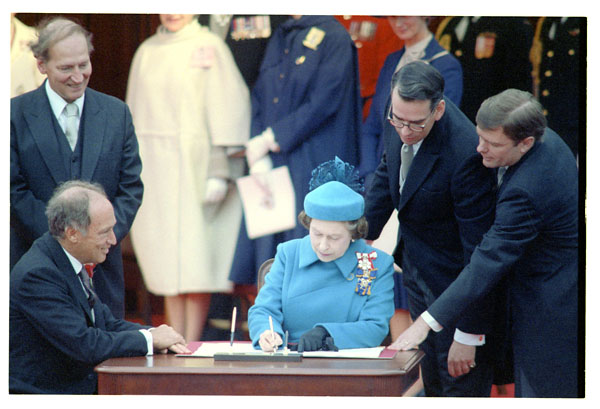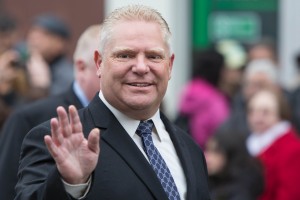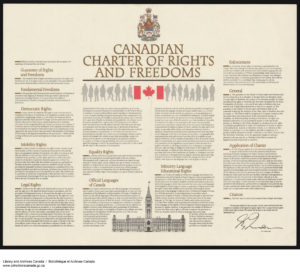Canada’s constitution – a rule made to be broken

Queen Elizabeth II signing the proclamation of the new Canadian Constitution in Ottawa on April 17, 1982. Prime Minister Pierre Trudeau is seated at the left. Behind the Queen, second from right is Michael Pitfield, Clerk of the Privy Council and alumnus of St. Lawrence University. Photo: Robert Cooper. Library and Archives Canada PA-140705
It isn’t all written down
Americans talk about their constitution a lot. Canadians, not so much. Unlike the U.S., Canada’s constitution is a lot less formal and some things in it aren’t even written down. It’s a mix of documents and traditions we borrowed from Britain. For example, it doesn’t even mention that a Prime Minister is necessary to lead a government. That job exists “because we’ve always done it that way” and solely at the pleasure of the Queen (or King).
Doug Ford’s deeds notwithstanding
A part of Canada’s constitution that is written down has caused a strong reaction in Ontario lately. It’s Section 33 of the Canadian Charter of Rights and Freedoms, the so-called “notwithstanding clause.” It says that a provincial legislature or Parliament can pass laws that contravene the Charter of Rights and Freedoms if it believes there is an advantage to doing so. The only catch is that the use of the clause must be renewed every five years.

Doug Ford is Ontario’s Conservative Premier. Photo: Bruce Reeves, Creative Commons, some rights reserved
Soon after taking office in June, Ontario Premier Doug Ford’s conservative government passed a law that would have reduced the size of Toronto’s city council to 25 members from 47. That move sparked widespread complaints and protest, including from Toronto’s moderate conservative Mayor, John Tory. The local connection to the story is that the Minister of Municipal Affairs, who is responsible for provincial relations with cities and towns, is Steve Clark, a former Mayor of Brockville who represents Leeds-Grenville-Thousand Islands and Rideau Lakes in the legislature.
A group of citizens challenged the new law in court and on September 10, the law was declared in contravention of the Charter of Rights and Freedoms. One of the judge’s main reasons for striking down the law was that it went against democratic rights to change the election rules during a campaign period. The next city council election in Toronto is on October 22. Premier Ford, who likes to repeatedly use his “For the people” slogan, angrily called the court ruling undemocratic and said his government was elected and the Superior Court Justice was not. Then, he said he was going to use the notwithstanding clause and press ahead with cutting the size of Toronto’s council. Ford also said he would use the notwithstanding clause again if any of his government’s initiatives were struck down in court.
Ford recalled the legislature and the bill was re-introduced. Things have been wild inside the chamber since. On Wednesday, Speaker Ted Arnott, could barely keep control of the place. Almost all the entire New Democratic Party (NDP) caucus was ejected for the rest of the day because of their raucous behavior to slow down the bill, which still passed first reading anyway because Ford’s Conservatives hold a majority. The scene repeated itself again on Thursday morning.

The Canadian Charter of Rights and Freedoms. Library and Archives Canada, R11274-148
The results of history
The notwithstanding clause has never been used before in Ontario. The Canadian Charter of Rights and Freedoms is equal to the Bill of Rights part of the U.S. Constitution. The Charter never existed before 1982. A separate Bill of Rights had been passed in the late 1950s, but it was just an act of Parliament and could be ignored because it had no constitutional standing.
In the early 1980s, Prime Minister Pierre Trudeau was attempting to “patriate” Canada’s constitution from Britain. The highest level of constitutional authority in Canada at the time was still the Judicial Committee of the Privy Council in the British parliament. Some provincial Premiers opposed Trudeau’s plan to include the Charter in the new constitution because they thought it would intervene on laws passed by their legislatures. Canadian provinces don’t have individual constitutions like U.S. states do. As a condition of giving Trudeau consent to patriate the constitution from Britain and include the new Charter, they insisted the notwithstanding clause be included in it.
Ironically, Ontario had a role in getting the controversial clause included in the constitution. In November 1981, the prospects of patriation were looking grim for Pierre Trudeau. According to journalist Steve Paikin and Claire Hoy’s biographies of Davis, a late-night phone call from then-Ontario Premier William G. Davis to the Prime Minister saved the process. One of the things Davis said to Trudeau was that he had to accept the inclusion of the clause if he was going to get the support of all the Premiers. The Prime Minister accepted and the patriation process went ahead, with only Quebec not in favor, but the Supreme Court ruled that patriation could happen anyway. Davis, a moderate conservative in the Red Tory/Rockefeller Republican fashion, was personally opposed to the notwithstanding clause but agreed with it as a compromise. He said it would never be used in Ontario and the Charter would always be respected.
37 years later, Davis, now 88, is not Premier and Doug Ford, a very different kind of conservative is running the province. Seven other provinces have used the clause over the years. As an example, Quebec has used it to protect French language rights and push back against perceived encroachment by the federal government. Davis recently spoke against Ford’s use of the clause. Former Prime Minister Brian Mulroney, who succeeded Pierre Trudeau, was never a supporter of the clause either and recently said so publicly. Ironically, his daughter Caroline is now Attorney General in Doug Ford’s government.
So, Canada’s constitution has a rule government can use if they don’t want to follow the rules in the constitution. It affirms the saying “rules are made to be broken.”
Tags: canada, Charter of Rights and Freedoms, constitution, Doug Ford, politics






.jpg)
